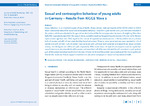Sexual and contraceptive behaviour of young adults in Germany - Results from KiGGS Wave 2
Hintzpeter, Birte
Krause, Laura
Vogelsang, Felicitas
Prütz, Franziska
Sexual behaviour is an important aspect of sexual health. 18-year-old and older participants of the KiGGS cohort in KiGGS
Wave 2 were asked about their sexual and contraceptive behaviour. Data from 2,966 women and 2,206 men were included in
the analysis, which was adjusted to the age and sex distribution of the German population by means of weighting. More than
half of the respondents report their first sexual intercourse before reaching the age of majority (women 61%, men 53%). Women
report a lower age than men. With regard to the number of opposite-sex sexual partners in the last twelve months, almost
69% of women and 58% of men state that they have had contact. Three or more sexual partners were reported by 11% of
women and 20% of men. 7.4% of women have same-sex and 1.4% have both same-sex and opposite-sex sexual contacts,
among men the figures are 2.8% and 0.4%, respectively. When asked about the type of contraception used during the last
sexual intercourse, about two thirds of the women and more than half of the men indicated the pill; a condom is used by about
44% of the women and about two thirds of the men. Almost one third of the women have already taken the morning-after pill.
Overall, the results can help to support prevention and education campaigns on sexual and reproductive health.
Dateien zu dieser Publikation

